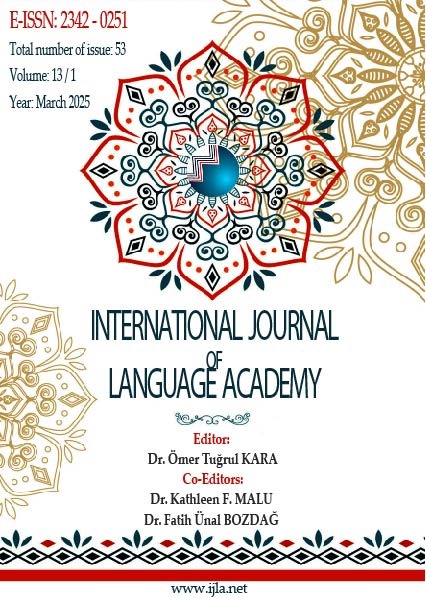Author :
Abstract
Bu çalışma, Ömer Seyfettin'in Bahar ve Kelebekler adlı hikâyesini ekofeminist bir perspektiften analiz etmeyi amaçlamaktadır. Bu hikâye, kadın ve doğa arasındaki metaforik bağlantıları, kadının özgürleşme mücadelesini ve ataerkil toplum tarafından kadınlara uygulanan kısıtlamaları ele alması nedeniyle ekofeminist bir okumaya elverişlidir. Çalışmada, hikâyedeki kelebeklerin sembolik kullanımı, nesiller arası farklılıklar ve kadının ataerkil yapıya karşı mücadelesi ekofeminist bir çerçevede incelenmiştir. Genç kızın doğayla kurduğu güçlü bağ ve büyük nine ile olan çatışması, kadının özgürleşme arzusunu ve toplumsal kısıtlamalarla karşılaşmasını yansıtmaktadır. Kelebeklerin kısa ömürlü fakat özgür yaşamları, kadının toplumdaki geçici rollerine ve özgürlük arayışına işaret etmektedir. Siyah kelebek sembolü aracılığıyla doğa ve kadının ataerkil baskılar altındaki ortak kaderi vurgulanmıştır. Doküman incelemesi yöntemiyle gerçekleştirilen bu çalışma, hikâyedeki doğa tasvirleri, semboller ve karakterler arasındaki ilişkiler üzerinden ekofeminist temaları ortaya koymaktadır. Ömer Seyfettin'in anlatımı, doğa ve kadının ataerkil sistemler tarafından nasıl sınırlandırıldığını ve bu baskıya karşı verilen özgürleşme mücadelesini göstermektedir. Çalışma, ekofeminist kuramın edebiyat eserlerinin analizinde uygulanabilirliğini gösterirken, edebiyatın toplumsal eleştiri yapma gücünü de vurgulamaktadır. Sonuç olarak, Bahar ve Kelebekler hikâyesi, kadının toplumsal baskılara rağmen özgürleşme mücadelesini ve doğanın korunmasıyla bu mücadelenin nasıl iç içe geçtiğini göstermektedir. Sonuç olarak, bu makale hikâyeyi ekofeminizm bağlamında ele almaktadır. Bu çalışma ile edebiyat eserlerinin ekofeminist kuram ışığında incelenmesinin, toplumsal ve çevresel sorunların anlaşılmasına ve çözümüne katkıda bulunabileceği ortaya konulmaktadır.
Keywords
Abstract
This study aims to analyze Ömer Seyfettin's story, Bahar ve Kelebekler (Spring and Butterflies), from an ecofeminist perspective. This story is suitable for an ecofeminist reading due to its handling of the metaphorical connections between women and nature, the women's struggle for liberation, and the restrictions imposed on women by patriarchal society. This study examines the symbolic use of butterflies in the story, intergenerational differences, and the woman's struggle against the patriarchal structure within an ecofeminist framework. The strong bond the young girl establishes with nature and her conflict with the great-grandmother reflect the woman's desire for liberation and her confrontation with societal restrictions. The short-lived but free lives of the butterflies point to the woman's temporary roles in society and her quest for freedom. Through the symbol of the black butterfly, the shared fate of nature and women under patriarchal pressures is emphasized. This study, conducted using the document analysis method, reveals ecofeminist themes through the nature depictions, symbols, and relationships between characters in the story. Ömer Seyfettin's narration shows how nature and women are constrained by patriarchal systems and the struggle for liberation given against this oppression. While demonstrating the applicability of ecofeminist theory in the analysis of literary works, the study also emphasizes the power of literature to make social criticism. In conclusion, the story Bahar ve Kelebekler (Spring and Butterflies) shows the woman's struggle for liberation despite social pressures and how this struggle is intertwined with preserving nature. In conclusion, this article addresses the story in the context of ecofeminism. It is revealed that analyzing literary works in the light of ecofeminist theory can contribute to the understanding and solving social and environmental problems with this study.





